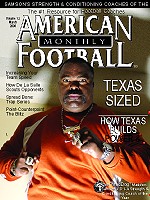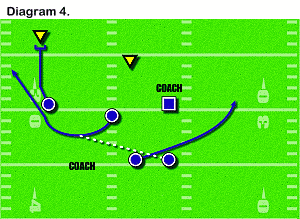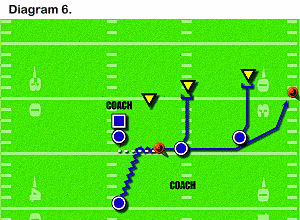AMERICAN FOOTBALL MONTHLY THE #1 RESOURCE FOR FOOTBALL COACHES
Article CategoriesAFM Magazine
|
The Drills ReportBubble Screen Drillby: Wayne Anderson © More from this issue Sponsored by: Rogers Athletic Company As coaches, we are always looking for new and innovative ideas to help improve the play of our athletes. As in any other setting, practice makes perfect and practice on the football field involves drills. American Football Monthly’s newest feature is dedicated to finding creative drills that coaches can implement into their programs. The subject matter will be broad in scope and will be selected from coaches of all levels; from high school through professional. This month’s drill is a Bubble Screen Drill that I used as an Offensive Coordinator for Nidaros Domers American Football Club in Trondheim, Norway during the 2005 season. Like other spread offensive teams, the Bubble Screen was an intricate part of our Green Machine offense. In this feature, I will explain the techniques of the QB and the skill positions, explain how to set up the drill and discuss implementation of the drill. A. Quarterback Technique (As written for a right handed quarterback) Under Center – Footwork (Diagrams 1, 2, 3, & 5) To the Left: First Step Hinge step back with your right foot to create separation from the line of scrimmage. The quarterback’s toe should be pointing at 12 o’clock. Separation will vary depending on the size of the quarterback. Second Step Is an open step with the left foot with the toe pointing at the intended receiver running the bubble route. To The Right All footwork technique is the same except on the first step with the right foot. Instead of the toe being at 12o’clock, it needs to be at 3 o’clock. this will help with opening the quarterback’s hips properly. In the Shotgun – Footwork (Diagram 4) All of the footwork is the same except that the play action fake is added with the single back. Side Notes: When throwing the ball, it is always important for the quarterback to use the outside number/outside shoulder of the receiver as his focal point to deliver the ball. Like pitching the ball on a toss sweep play, the quarterback needs to lead the receiver to the ball, no throw it behind him. 
Receiver Technique (Diagrams 1 & 2) 
Stationary Position Stance: Inside leg is up with the weight on the inside part of the foot. The front knee is slightly bent to the inside. This will help take away any false step with the inside leg. At the Snap of the Ball: Simultaneously, the receiver will push off with his inside foot and snap his head back to the quarterback while having his outside foot and shoulders parallel to the line of scrimmage. While staying parallel to the line of scrimmage, the receiver must run at a level of speed in which he can maintain body control. After catching the ball, the receiver will then accelerate to full speed maintaining outside leverage. In Shotgun (Diagram 4):  The only difference is that the receiver must gain some depth on his first three steps while keeping his shoulders parallel to the line of scrimmage. The first three steps the receiver takes should be at 5 o’clock. The receiver must then allow the quarterback to throw him open.
The only difference is that the receiver must gain some depth on his first three steps while keeping his shoulders parallel to the line of scrimmage. The first three steps the receiver takes should be at 5 o’clock. The receiver must then allow the quarterback to throw him open.
In Motion (Diagram 3 & 5): 
 After motioning across the formation and when the ball is snapped, revert back to the stationary receiver techniques.
After motioning across the formation and when the ball is snapped, revert back to the stationary receiver techniques.
B. Setting Up the Drill (Diagram 1): Coaching Points- 1. Most importantly, always have a center snapping the ball in this drill. 2. Have the receiver running the Bubble Screen on a line. 3. Have the outside receiver on the line of scrimmage that is determined by the center. 4. Put a cone on the sideline four yards from the line of scrimmage. 5. Have one coach with a stopwatch in front of the center. It is his job to time the throw of the quarterback and chart his progress. Side Note: To work on the quarterback’s ability to throw this pass with greater accuracy, the center needs to be placed at a proper depth so that with the quarterback’s footwork, he is stepping and throwing down the same line that the receiver is on. Have two defenders (who are receivers) at about seven to eight yards in depth over the two receivers. C. Implementation: Coaching Points - 1. Before the snap, the coach behind the receiver running the Bubble Route will point to the defender who will attack the Bubble Route. 2. After the snap, the outside receiver will take a read step up field with his head on a swivel to determine who is the most dangerous man to block. When this is determined, it is the receiver’s job to wall off the defender if the pressure comes from the inside. If it is outside pressure and depending on what angle the defender takes, the receiver can either wall him off to the inside or block the defender out of bounds. 3. The receiver running the Bubble Route is responsible for catching the ball first and then getting past the landmark. 4. Keep the drill moving by rotating your personnel after each snap so everyone gets repetitions. 5. Make sure you run the drill equally to both sides. 6. Adjust the distance of the throws the quarterback makes from the middle of the field to the hash marks. Also work throws to the wide side of the field and the boundary side. 7. You can also change up the drill by adding player, using motion or going into the shotgun. (Diagram 2, 3, 4 & 5) Given our unique practice situation with the Domers (time, having enough players and areas to practice), I tried to run this drill during at least one of our practice sessions each week. This is the first installment of American Football Monthly's featured drill. Each month a new drill will be featured and include the most innovative offense, defense, and special team drills. 
Coach Wayne Anderson is the Football Drills Editor for American Football Monthly. Anderson has coached on the high school, collegiate, and international level for 17 years. We welcome suggestions and comments as well as publishing offensive, defensive, and special teams drills. He can be reached at WayneAnderson@AmericanFootballMonthly.com |
|
| HOME |
MAGAZINE |
SUBSCRIBE | ONLINE COLUMNISTS | COACHING VIDEOS |
Copyright 2024, AmericanFootballMonthly.com
All Rights Reserved




